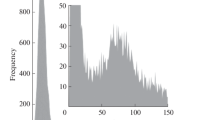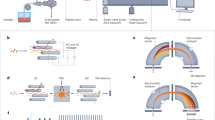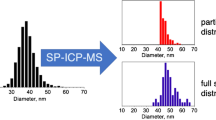Abstract
The quality of the quantitative information in single-particle inductively coupled plasma mass spectrometry (SP-ICP-MS) depends directly on the number concentration of the nanoparticles in the sample analyzed, which is proportional to the flux of nanoparticles through the plasma. Particle number concentrations must be selected in accordance with the data acquisition frequency, to control the precision from counting statistics and the bias, which is produced by the occurrence of multiple-particle events recorded as single-particle events. With quadrupole mass spectrometers, the frequency of data acquisition is directly controlled by the dwell time. The effect of dwell times from milli- to microseconds (10 ms, 5 ms, 100 μs, and 50 μs) on the quality of the quantitative data has been studied. Working with dwell times in the millisecond range, precision figures about 5 % were achieved, whereas using microsecond dwell times, the suitable fluxes of nanoparticles are higher and precision was reduced down to 1 %; this was independent of the dwell time selected. Moreover, due to the lower occurrence of multiple-nanoparticle events, linear ranges are wider when dwell times equal to or shorter than 100 μs are used. A calculation tool is provided to determine the optimal concentration for any instrument or experimental conditions selected. On the other hand, the use of dwell times in the microsecond range reduces significantly the contribution of the background and/or the presence of dissolved species, in comparison with the use of millisecond dwell times. Although the use of dwell times equal to or shorter than 100 μs offers improved performance working in single-particle mode, the use of conventional dwell times (3–10 ms) should not be discarded, once their limitations are known.





Similar content being viewed by others
References
Degueldre C, Favarger P-Y. Colloid analysis by single particle inductively coupled plasma-mass spectroscopy: a feasibility study. Colloids Surf A Physicochem Eng Asp. 2003;217:137–42.
Heithmar EM, Pergantis SA. Characterizing concentrations and size distributions of metal-containing nanoparticles in waste water, EPA/600/R-10/117. U.S. Environmental Protection Agency; 2010.
Laborda F, Jiménez-Lamana J, Bolea E, Castillo JR. Selective identification, characterization and determination of dissolved silver(I) and silver nanoparticles based on single particle detection by inductively coupled plasma mass spectrometry. J Anal At Spectrom. 2011;26:1362–71.
Pace HE, Rogers NJ, Jarolimek C, Coleman VA, Higgins CP, Ranville JF. Determining transport efficiency for the purpose of counting and sizing nanoparticles via single particle inductively coupled plasma mass spectrometry. Anal Chem. 2011;83:9361–9.
Laborda F, Bolea E, Jiménez-Lamana J. Single particle inductively coupled plasma mass spectrometry: a powerful tool for nanoanalysis. Anal Chem. 2014;86:2270–8.
Peters R, Herrera-Rivera Z, Undas A, van der Lee M, Marvin H, Bouwmeester H, et al. Single particle ICP-MS combined with a data evaluation tool as a routine technique for the analysis of nanoparticles in complex matrices. J Anal At Spectrom. 2015;30:1274–85.
Hineman A, Stephan C. Effect of dwell time on single particle inductively coupled plasma mass spectrometry data acquisition quality. J Anal At Spectrom. 2014;29:1252–7.
Montaño MD, Badiei HR, Bazargan S, Ranville JF. Improvements in the detection and characterization of engineered nanoparticles using spICP-MS with microsecond dwell times. Environ Sci Nano. 2014;1:338–46.
Olesik JW, Gray PJ. Considerations for measurement of individual nanoparticles or microparticles by ICP-MS: determination of the number of particles and the analyte mass in each particle. J Anal At Spectrom. 2013;27:1143–55.
Tuoriniemi J, Cornelis G, Hassellöv M. Size discrimination and detection capabilities of single-particle ICPMS for environmental analysis of silver nanoparticles. Anal Chem. 2012;84:3965–72.
Laborda F, Jiménez-Lamana J, Bolea E, Castillo JR. Critical considerations for the determination of nanoparticle number concentrations, size and number size distributions by single particle ICP-MS. J Anal At Spectrom. 2013;28:1220–32.
Cornelis G, Hassellöv M. A signal deconvolution method to discriminate smaller nanoparticles in single particle ICP-MS. J Anal At Spectrom. 2014;29:134–44.
Lee S, Bi X, Reed RB, Ranville JF, Herckes P, Westerhoff P. Nanoparticle size detection limits by single particle ICP-MS for 40 elements. Environ Sci Technol. 2014;48:10291–300.
Hadioui M, Peyrot C, Wilkinson KJ. Improvements to single particle ICPMS by the online coupling of ion exchange resins. Anal Chem. 2014;86:4668–74.
Laborda F, Medrano J, Castillo JR. Quality of quantitative and semiquantitative results in inductively coupled plasma mass spectrometry. J Anal At Spectrom. 2001;16:732–8.
Laborda F, Medrano J, Castillo JR. Influence of the number of calibration points on the quality of results in inductively coupled plasma mass spectrometry. J Anal At Spectrom. 2004;19:1434–41.
Acknowledgments
The authors thank D.M. Escala (Group of Non-linear Physics, University of Santiago de Compostela, Spain) for developing the MatLab programs for data processing.
Author information
Authors and Affiliations
Corresponding author
Ethics declarations
Funding
This work was supported by the Spanish Ministry of Economy and Competitiveness, projects CTQ2012-38091-C02-01, CTQ2012-38091-C02-02, CTQ2015-68094-C2-1-R and CTQ2015-68094-C2-2-R.
Conflict of interest
The Syngistix™ Nano Application Module was provided by Perkin Elmer.
Additional information
Published in the topical collection Single-particle-ICP-MS Advances with guest editors Antonio R. Montoro Bustos and Michael R. Winchester.
Rights and permissions
About this article
Cite this article
Abad-Álvaro, I., Peña-Vázquez, E., Bolea, E. et al. Evaluation of number concentration quantification by single-particle inductively coupled plasma mass spectrometry: microsecond vs. millisecond dwell times. Anal Bioanal Chem 408, 5089–5097 (2016). https://doi.org/10.1007/s00216-016-9515-y
Received:
Revised:
Accepted:
Published:
Issue Date:
DOI: https://doi.org/10.1007/s00216-016-9515-y




